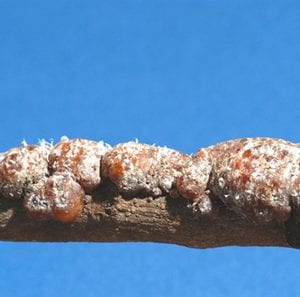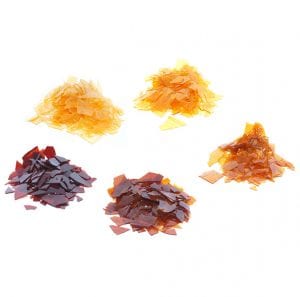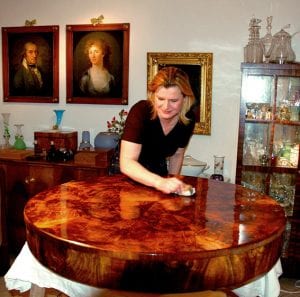French Polish History
How do we French polish to high standards?
The answer is down to understanding the history of French polishing and from this we can understand how it works when applied to furniture. With patience and care we can get to a position where French Polishing is the last part of a restoration journey that results in fantastic results for the furniture in the restorers care and that meets and exceeds client expectations.
The History
French polishing is a process that, as we know it, has been around using pretty much the same method for 200 years but its use can be traced back as far as 250 AD and was used extensively in India, on lathe finished wood turnings before the end of the 16th century. So French Polishing has been around for a while.

The Lac, tunnel-like tube from the Kerria lacca insect
What is French Polishing?
The key ingredient in French Polish is shellac – shellac is made from the secretion collected from an aphid like insect found in Thailand and India, the insect produces the ‘lac’ to protect its larvae and this is collected and refined with an end process that results in a thin film of shellac resin being formed and then this is then turned in to flakes once dry and then reconstituted to a liquid, with a solvent base, to make the polish form of the liquid that we still use today.

Different coloured shellac flakes
Why French Polish?
As the term indicates, it was used extensively in France by Victorian era furniture makers to add a highly polished surface to many furniture pieces. The process involves a specific combination of different application techniques to apply the shellac in a thin uniform layer. The process is lengthy and repetitive and is achieved by applying thin layers of shellac with a material pad called a rubber or a brush (called a mop). The thin coats are cut back between layers often with fine wire wool before the next layer is applied. Each coat must be fully dry before the next application, to avoid lifting out the softened finish. The end result of often up to 20 coats, is a phenomenal finish that compliments the furniture piece beautifully.

French Polished Furniture
Why use French Polishing?
In an age when synthetic material use and type has never been so diverse and this includes furniture polish and lacquer finishes, why use a product that is as old as the hills and relies on the vagaries of insect reproduction to create it? – the answer here is two fold – the history bit is a clue, for restoration work to use a product that has a history that is often as old as the furniture it is being applied to is very sympathetic to the application – ask a restorer and they tell you it just feels right to use it ! But it also has many properties that also make it the correct product to use – these include;
• UV resistant – and it does not colour with time • It will withstand exposure to water for short time periods – especially if maintained • It is not a ‘brittle’ product so does not scratch like hard modern finishes • It will adhere to almost any surface • Its non-toxic and hypoallergenic • It is odourless once the carrier solvent has evaporated • It is an all natural product harvested from the insect secretions and as such is from a renewable resource.
French Polish – what’s not to love! – interested in getting a piece of furniture re-finished please get in touch.
Traditional French polishing is often the most suitable procedure for antique furniture, however there is an alternative process for modern furniture is modern durable spray applied finishes, we can offer the correct finish for your item of furniture. Sometimes all that is required is a clean and re-polish. However for a complete renovation or change of colour, we will strip the wood back to the natural timber, stain the wood to the colour of your choice, or just leave it natural and polish to the required finish.
From a minor scratch/mark to a full strip and refinish no job is too big or too small. Modern spray applied clear lacquers and painted colours are our speciality colour matched to all the popular main paint manufacturers. ie. Dulux, Crown, Farrow & Ball, Fired Earth etc. We can re-spray all unfashionably coloured items of furniture to painted finishes at a fraction of the cost of purchasing new. Recycling current items of furniture is kinder to the environment.
French Polish finishes available.
All finishes listed below are available in the sheen levels from a dead matt to a high gloss sheen in pre-catalysed, acid-catalysed, water-based and polyurethane lacquers.
• Natural clear wood finished
• Tinted wood finished
• Stained wood colour finish
• Limed/wash colour finish
• Wenge/ebony colour finish
• Spray painted colours
• Antiqued/patina painted colours
• Distressed painted colours
